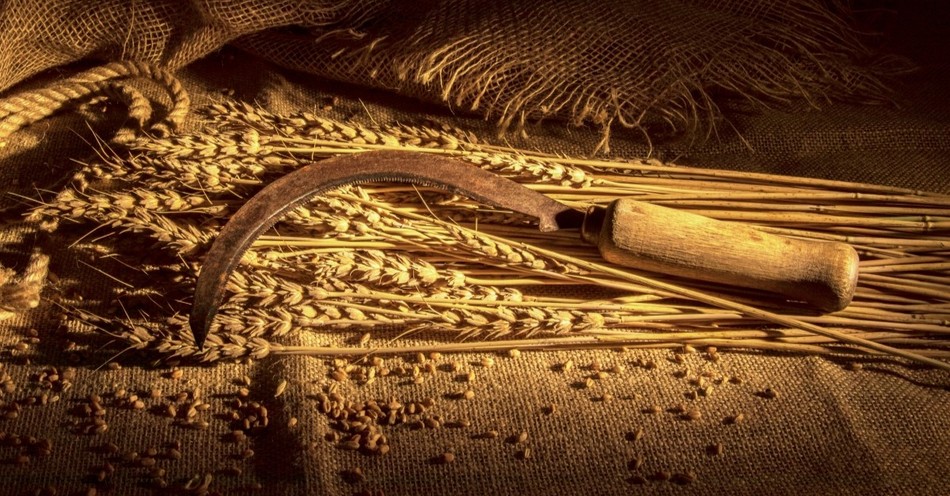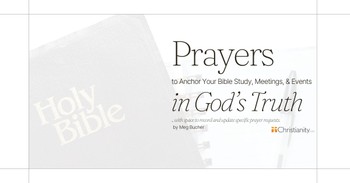The sharp sickle harvest represents a time when unbelievers will be “harvested” at the end of days.
For the most part, Scripture talks about harvesting with a positive connotation. We often think of the parable of the sower or other farming metaphors used throughout the Bible. Harvest tends to represent a time of plenty and provision; the Jewish people even had designated celebrations to recognize this. But in Revelation 14, harvesting takes on a different meaning. Enter the sharp sickle harvest.
Revelation 14, from which we get the term “grapes of wrath,” shows angels mowing the fields of the earth down with sharp sickles. There, the unbelievers will be gathered and trampled in God’s wrath. So why should we know about this yet-to-come event, and how can we be prepared? Let’s dive into the sharp sickle harvest.
What Is the Sharp Sickle Harvest in the Bible?
As mentioned above, the sharp sickle harvest is the harvesting during the events of Revelation of unbelievers.
Two reapers go out into the earth to sickle those who do not believe. And it’s such a bloody mess that the streets are pools of blood.
This begs the question of whether this event has occurred yet or has already happened. After all, we know of plenty of disasters and wars in which the death toll ran high. Commentaries point to the latter.
Here, we should point out the difference between how believers are described—during harvest seasons—and unbelievers.
Believers take on the role of wheat. You may have heard the term “separate the wheat from the chaff” (Matthew 3:12).
On the other hand, unbelievers are described as grapes in this passage. And although we fruit lovers may love a good grape, we must understand that grapes and wine represent God’s wrath in most Scriptural connotations. God’s wrath is poured out on those who have not submitted to him.
Notably, one of Jesus’ first miracles was turning water into wine, which cannot be a coincidence.
It’s also important to mention that God waits until the grapes are “ripe” in this passage. He still gives unbelievers plenty of time to repent and avoid God’s wrath.
What Does a Sickle Represent in the Bible?
At first glance, it can seem like a sickle represents a harvesting tool. And it certainly does. Farmers would’ve used these to thresh corn or, in the case of this passage, grapes.
But what else does it represent? According to Bible Study Tools, it can also represent an instrument of war. We can see this interpretation played out if we envision the sickle as a sword of God’s justice. In Revelation, God is described as a great warrior who goes to battle for his people. By the time the events of Revelation occur, all believers will be persecuted and crying out to God for help.
In media interpretations, a sickle is usually paired with the idea of a grim repear or death. But let’s see what the Bible has to say about the sickle.
- Deuteronomy 16:9 says that for the festival of weeks (a harvesting holiday), farmers would use a scythe to harvest “standing grain.”
- Jeremiah 50:16 talks about Babylon getting sickled. Although Babylon was an instrument of God’s wrath against the sins of the kingdom of Judah, the Babylonians took it too far. Because of that, they were going to be reaped by God.
- Joel 3:13 discusses the sickle in terms of God’s wrath and “ripe harvest.” Once again, we see the imagery of grapes being used here. Their wickedness has reached a point of “ripeness.” In other words, no return.
- Mark 4:29 once again uses this imagery in terms of grain.
Something we ought to take away from these passages is God gives a period of mercy. He always allows people to come to repentance for a time before their wickedness becomes too great. Unfortunately, many remain in sin and never humble themselves before him.
Does Revelation 14 Describe Two Harvests?
It certainly seems to. The passage we are discussing describes two reapers going out at two different appointed times.
So what does the first harvest represent if the second one reaps unbelievers?
Most likely, the first harvest is the gathering of believers, which happens before the White Throne Judgment reserved for unbelievers.
Some Christians interpret this as a pretribulation rapture that will take place (like the events imagined in the Left Behind series). Some believe it will happen mid-tribulation, and others say it will not happen until after the antichrist persecutes Christians for seven years.
No matter what the case, believers are apparently carried into heaven before the second harvest occurs with unbelievers.
Ultimately, figuring out exactly when the first harvest will occur isn’t the point. No one can truly interpret how the events of Revelation will play out, try as we might. What matters is that Christ will eventually gather believers and reap unbelievers, and every deed done in darkness will come to light.
What Can We Learn from the Sharp Sickle Harvest?
The sharp sickle harvest in Revelation 14 is yet to come. In the meantime, what can we believers take away from this passage?
First, we need to understand both God’s wrath and God’s mercy. If you’ve ever observed plant life and which plants bear fruit, you know something: they take a long time to cultivate that fruit. I often think of the pear trees in my childhood neighborhood. Although the trees had been there for how many years—stinking up the streets with their smelly flowers (sorry to any pear tree lovers out there)—they didn’t bear fruit.
Trees can take years (even a decade) to start bearing fruit. And the passage describes the grapes of wrath as “ripe.”
This means that God allows a long time for people to return to him. His mercy abounds. As believers, we ought to exercise mercy as well. If God can be gracious in his timing, so can we with unbelievers. It is up to him to determine when his wrath will take place.
Second, we need to know the difference between the two harvests. A lot of two pairings happen in Revelation. The two groups—the lambs and the goats. The two judgments—the Judgment Seat of Jesus Christ and the White Throne judgment. The two harvests—believers and unbelievers. There’s no middle ground when it comes to believing in Christ or not believing in him. There’s a reason why Revelation speaks against fence-sitting, lukewarm Christians. At the end of time, two groups exist, and there will be no more waiting.
Finally, we need to familiarize ourselves with the Bible’s agricultural metaphors. In our postmodern society, these metaphors can often be lost on us. How many of us have even seen a sickle, much less used one to harvest anything? We can miss the nuances if we don’t understand the agricultural imagery. In the case of the sharp sickle harvest, we need to get the role that grapes play in the Bible and how they often have associations with God’s wrath. We must see the parallels between Jesus’ first miracle and his final judgment.
The more we can understand the interconnected nature of the Bible, the better chance we have to see God moving in each period of history. We see that he truly is the same yesterday, today, and tomorrow. We learn how to prepare to see the signs of when he is truly coming to harvest us and bring us into communion with him.
Photo Credit: Getty Images/Andrey Iudin
Hope Bolinger is an acquisitions editor at End Game Press, book editor for hire, and the author of almost 30 books. More than 1500 of her works have been featured in various publications. Check out her books at hopebolinger.com for clean books in most genres, great for adults and kids. Check out her editing profile at Reedsy.com to find out about hiring her for your next book project.
This article is part of our larger End Times Resource Library. Learn more about the rapture, the anti-christ, bible prophecy and the tribulation with articles that explain Biblical truths. You do not need to fear or worry about the future!
The Second Coming of Jesus
Who Are the 144,000 in Revelation?
Who Are Gog and Magog in the Bible?
What Is the Apollyon?
Is the Apocalypse Mentioned in the Bible?
Signs of the End Times and the Rapture

.jpg)

.jpg)
